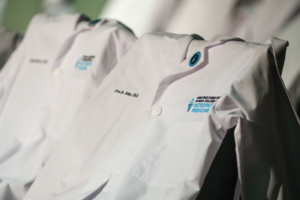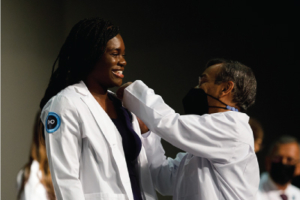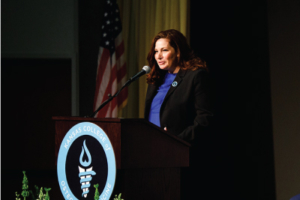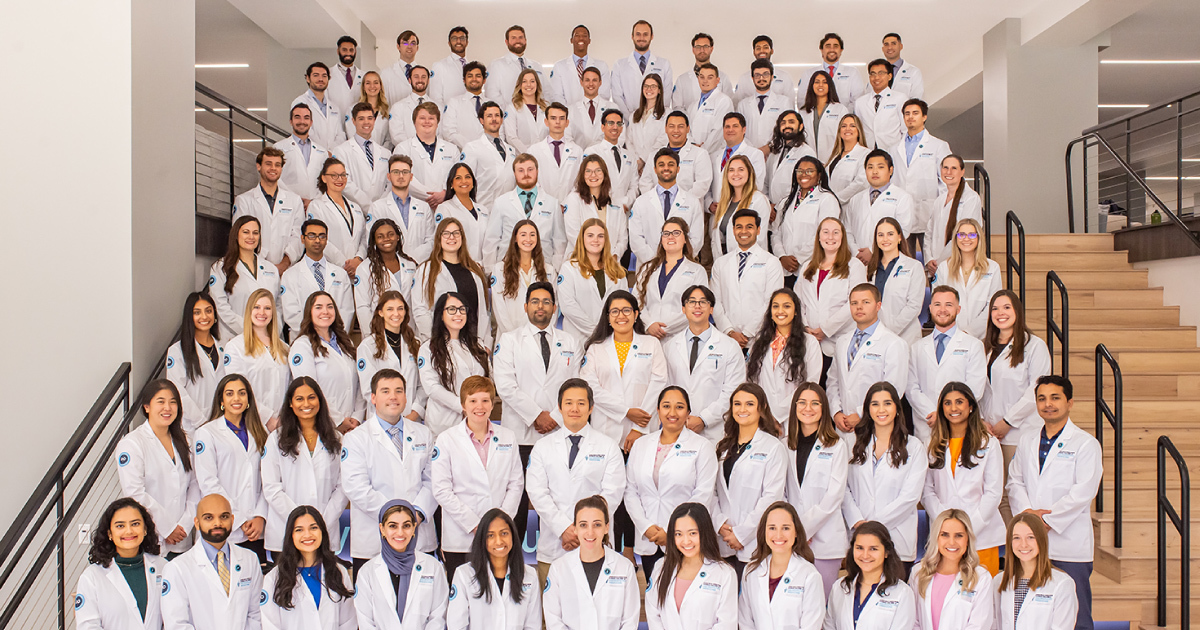In a solemn but joyous ceremony, 91 future doctors of osteopathy begin their journey toward a career of helping others.
This fall, 91 newly minted medical students of the class of 2026 made history as the first to attend the Kansas College of Osteopathic Medicine (KansasCOM), which opened its doors in Wichita in August of 2022. At a time when the U.S. is facing a critical shortage of physicians and an even greater shortfall in rural areas, these future osteopathic doctors are likely to have an enduring impact on the community and the state.
This first cohort of student-doctors averages 25 years in age. Enrollees include 48 women and 42 men. While they hail from 23 states, 20 of them are from Kansas. These student-doctors are training to be doctors of osteopathy (DO), a branch of medicine that represents approximately 11% of all physicians in the U.S. and focuses on the entire body. The practice is a patient-centered approach that stresses the importance of listening to patients and promoting general wellness.
 A rite of passage
A rite of passage
As is the tradition for incoming classes at medical schools across the country, the students were officially welcomed to KansasCOM in a white coat ceremony, signifying the first step on the journey to becoming physicians. “This is the first day of something really big,” says Gangadhar Dasa, M.D., assistant dean of clinical education at KansasCOM, “the inauguration of the students into a four-year program that is going to shape them into the physicians of tomorrow.” For Dr. Dasa, the white coat “signifies the humanism that comes along with the craft of medicine.”
During the ceremony, each student says their name while faculty drape them with white coats and present their official lapel pins. New students like Tanya Gupta see the honored tradition as a formal but exciting occasion.
The class of 2026 is a diverse group, something students expressed was an important reflection of KansasCOM’s commitment to serving the needs of their communities. Tyler Wilson says what drew him to KansasCOM was the “passion of administrators for diversity and community health.” The students who have immigrated from other countries have personally experienced the challenges many of their patients may face. Udisa Chowdhury of Queens, New York, immigrated from Bangladesh when she was thirteen. “I come from a low-income, immigrant background, and my goal is to serve Medicare patients or patients without insurance,” she says. Julia McCann, who is originally from Russia, says, “Coming from another country, I am looking to help new immigrants and people from underserved populations.”
serving the needs of their communities. Tyler Wilson says what drew him to KansasCOM was the “passion of administrators for diversity and community health.” The students who have immigrated from other countries have personally experienced the challenges many of their patients may face. Udisa Chowdhury of Queens, New York, immigrated from Bangladesh when she was thirteen. “I come from a low-income, immigrant background, and my goal is to serve Medicare patients or patients without insurance,” she says. Julia McCann, who is originally from Russia, says, “Coming from another country, I am looking to help new immigrants and people from underserved populations.”
A symbol of service
David Ninan, DO, dean and chief academic officer of KansasCOM, recalls similar emotions. “For me, the ceremony was the culmination of a life dream,” he says. “My dad was that classic immigrant who came to this country with nothing. He dreamed of being a doctor but couldn’t. He bet it all on the kids, and they were there to watch me. It was just a super-emotional and pivotal event.”
The fact that 20 students in the first class are from Kansas is significant because a recent study by the Association of American Medical Colleges focusing on how to solve the doctor shortage found that medical students that come from rural areas are most likely to return to them to practice. Dr. Dasa expects that commitment to service will extend throughout this inaugural class. “We’re very happy that we have students from Wichita and from all over the state,” he says, “but we’re also proud of the fact that we have students from all over the country. We think that a large number are going to settle in our communities in Kansas, especially in the more needy communities where there is an undersupply of health care.”
Medical Colleges focusing on how to solve the doctor shortage found that medical students that come from rural areas are most likely to return to them to practice. Dr. Dasa expects that commitment to service will extend throughout this inaugural class. “We’re very happy that we have students from Wichita and from all over the state,” he says, “but we’re also proud of the fact that we have students from all over the country. We think that a large number are going to settle in our communities in Kansas, especially in the more needy communities where there is an undersupply of health care.”
A commitment to community
Tiffany Masson, Psy.D., president and chief executive officer of KansasCOM, acknowledges the nationwide shortage of health care workers, which she sees growing exponentially over the next 10 years, as well as the needs of Kansans, for whom she expects an immediate and lasting impact. “Having a new medical school is a game-changer, not only from an economic perspective,” she says, “but also for the community.” Dr. Dasa points out that the students are already making a difference, having logged 400 hours of community service.
Dr. Masson sees the white coat ceremony as the symbolic beginning of this new reality for the students, the community, and the patients they will serve. “It’s an important rite of passage for our students to don their white coats, take their osteopathic oath, and to embark on their journey to become the extraordinary physicians that all of us can be proud of,” she says. “I couldn’t be more humbled to be a part of the transformation that our students will experience over the next four years.”

